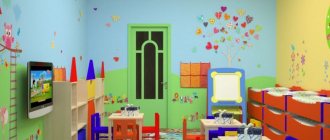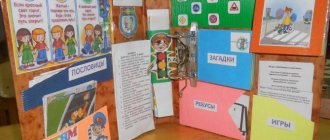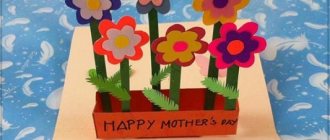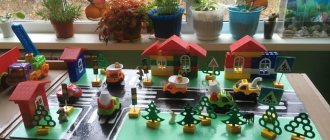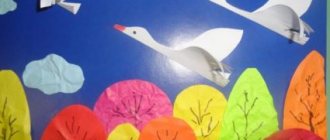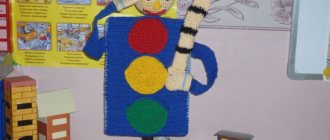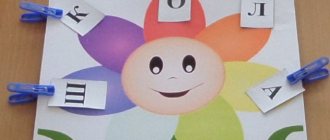Every interested parent goes through the experience of decorating children's themed corners with their own hands. The pets themselves and teachers participate in the creation of this mandatory element of the interior in preschool and school institutions.
The items that make up the composition can be crafts made during classes or specially selected items (souvenirs, printed materials) that have developmental significance.
In kindergarten and elementary grades, parents can also be involved in equipping the corners. Their indirect participation is also implied at subsequent stages of study, when students, having received an appropriate creative task, turn to family members for help.
Interior features in kindergarten
Decorating rooms for games and activities allows you to zoning the space and optimally use visual attributes in the process of raising and developing a child.
Thematic exhibitions with crafts and drawings complement the theme of the matinees; they can change in accordance with the seasons and holiday dates.
To create an exhibition board for drawings, the most suitable material is considered to be a lightweight cork sheet on which the paper can be fixed using buttons. It can be rectangular or with a curly cut.
The cork board is installed on a wooden, plastic or aluminum frame, which is firmly fixed to the wall. The surface of the stand can be painted or decorated with figures made of self-adhesive paper.
To create a display board, the content of which is updated daily, you can use a frame with stretched fabric, while the drawings are secured with safety pins.
Making your own passe-partout and special pockets for paper is an integral part of decorating corners in kindergarten.
The ability to abandon buttons and other metal fasteners will protect children and they will be able to change exhibits on their own.
To place bulky crafts, it is convenient to use narrow wall shelves. You can creatively add images of fairy-tale characters in poses supporting stands for figurines made by children into the background of the design.
Design of corners and play areas in kindergarten
Letucheva Ekaterina
Design of corners and play areas in kindergarten
Dear Colleagues! I present to your attention the design of corners and play areas in kindergarten. Each play area is constantly updated with visual aids produced by the teacher together with children and parents. Colorfully designed areas attract children's attention, increase interest in play activities, and allow them to effectively absorb program material
Locker room
Corner "Development"
Goal: familiarization with geometric figures and shapes of objects. Learning to group objects by color, size, shape. Development of thinking and finger motor skills. Mastering the operations of nesting, overlaying, connecting parts into a whole. Development of visual perception and attention. Formation of examination skills. Developing the ability to use language to determine the meaning of one's actions. Developing the ability to group objects and compose pictures sequentially. Enriching children's active vocabulary. Formation of the ability to describe and name objects in pictures.
Corner of role-playing games
Goal: formation of role-playing actions, communication skills in the game. Development of imitation and creative abilities. Develop the ability to use buildings made from building materials. (Dr. Aibolit, family and others)
Construction games corner
Goal: to develop ideas about the basic properties of volumetric geometric, mainly large forms (stability, instability, strength, in acquiring the skills to recreate familiar objects on a horizontal plane (paths, ladders, chairs, etc.), to develop skills of co-creation with adults, independent creativity, develop fine motor skills of fingers and hands. Develop the ability to build furniture, slides, houses. Learn to understand the modification, variability of design, the possibility of building not only horizontally, but also vertically. Be able to analyze an object, see the main parts of the part, the components of the structure, the ability to create them from various shapes.Develop fine motor skills and creative imagination.
Experimentation Corner
Goal: to promote the development in children of cognitive activity, curiosity, the need for mental impressions of children, the desire for independent knowledge and reflection
Corner of nature
Goal: enriching children's understanding of the diversity of the natural world, fostering love and respect for nature and the environment in general. Involving children in caring for plants. Formation of the beginnings of an ecological culture, an initial system of value orientations (perception of oneself as part of nature, the relationship between man and nature) Development of thinking, curiosity, cognitive activity.
Corner "Book House"
Goal: developing interest in the book, ability to handle the book. Teach children to listen to fairy tales, stories, poems. Develop an interest in illustrated books.
Sports and wellness corner
Goal: stimulate children's desire to engage in physical activity. Strengthen the muscles of the lower and upper extremities, the muscles of the spine, prevention of flat feet. To instill in children a conscious attitude towards their health. Provide and regulate the level of physical activity of children in the daily routine.
Music corner
Theater Corner
Goal: development of children's creativity based on literary works. Developing the ability to stage simple performances. Development of interest in theatrical and play activities.
Safety and young pedestrian corner
Goal: to consolidate children’s knowledge about traffic rules, rules of conduct on the street, to consolidate knowledge about traffic lights and rules of behavior in accordance with traffic light signals. Show with an example what a violation of traffic rules can lead to. Develop the habit of behaving correctly on the road. Develop attention, imagination, the ability to come up with a game situation, concentration, and logical thinking. Raise competent pedestrians.
ISO corner
Goal: formation of the creative potential of children, development of interest in art activities, formation of aesthetic perception, imagination, artistic and creative abilities, independence, activity. Development of finger motor skills.
Mathematics Corner
Corner of Patriotic Education
Goal: to develop cognitive interest in your country, hometown, village. To form patriotic feelings, to introduce the symbols of our country.
Speech Development Corner
Corner of solitude
A corner to connect with nature
The concept of decorating a corner of nature with your own hands depends on the age group and the ability to regularly care for the exhibits.
You can create a model of a farm or savannah with plastic figures. Nearby you can place cards with images of animals, insects and plants.
For children who can take part in watering and care, you can create a picturesque corner with climbing and exotic plants.
Nearby on the windowsill you can set up an indoor vegetable garden for germinating seeds.
As additional attributes, you can use temperature and humidity sensors, spray bottles and water containers, special cloths for cleaning plants, and spatulas for loosening.
You can use tree bark, pine cones, and herbariums to decorate the corner. In the common playroom, if regular specialized care is possible, you can also place an aquarium with fish.
Corners and centers in groups - Book corner in an early age group
Publication “Book Corner in the Early Years Group...” In the early age group “Rainbow” we created a book corner in which children can independently choose books and calmly look at them. The book corner turned out to be cozy and attractive. It is located away from where children play, so that noisy games do not distract the child, good…
Equipment in children's activity corners in a general developmental group for children 3–4 years old List of equipment in children's activity corners in a general developmental group for children 3–4 years old. "Bells" Social and communicative development. Safety corner Traffic rules poster; Transport – cars, Telephones D/i: “Professions”, Fire safety. . Corner...
The parent's corner in an early age group as the main form of the system of pedagogical support for parents in a preschool educational institution. The parent's corner in a kindergarten has long been used to make it more convenient and interesting for parents to get acquainted with the life of the kindergarten and group. Information must be displayed correctly, namely beautiful design, proper placement, accessibility, relevance and...
Physical education corner in an early age group Early age is an important period in the formation of the human personality, the period when the foundations of physical health are laid. It is very important to teach your child to walk, run, jump, crawl, handle various objects, use hands and fingers,…
Rack for sports equipment
Decorating a sports corner with your own hands is done in the active games area. For bright hoops, clubs, balls and jumping ropes, it is necessary to organize aesthetic and convenient storage with special holders, nets and shelves.
To equip the corner, you need to use the safest plastic or fabric products.
The contents of the exhibition can be supplemented with homemade items, such as fake fishing rods or other devices for developing dexterity.
Information board in children's institutions
When decorating a corner for parents with your own hands, the overall aesthetics of the institution are preserved.
The composition, as a rule, is placed in the reception area, the most optimal place is above the changing lockers or at the entrance to the room. A section of the wall is decorated with bright, cheerful drawings or wall relief figures, the details of which can be supplemented with seasonal or festive elements.
Subject developmental compositions in kindergartens
Exhibits with special paraphernalia on traffic rules, hygiene and healthy eating, shelves with musical instruments, books or pencils are also located in separate areas with a thematic design.
According to the requirements of modern pedagogy, privacy zones can also be created in playrooms and classrooms - houses, tents, curtained areas with upholstered furniture.
In the process of decorating corners with your own hands, you can use photo collections with successful solutions.
Project in the middle group “Duty Corner”
Middle group project
“Group duty corner”
Name of the organization implementing the project: Chernogorsk MBDOU "Teremok"
Completion time: project duration: 1 year
Project participants: teachers, middle school children, parents.
Relevance of the project:
Raising the younger generation in the spirit of respect and love for work is one of the main tasks of a preschool institution. Labor education, i.e., involving children in independent work within their capabilities and observing the work of adults, explaining its significance in people’s lives, plays an important role in the comprehensive development of the child’s personality. The main goal of labor education for children of middle preschool age is the formation of moral guidelines, hard work, and awareness of the usefulness of work. The work activity of a preschooler has a significant impact on the development of the child’s volitional traits, his thinking, speech, memory, attention, and imagination. From preschool age, every child must take part in work and perform simple duty duties.
Duty duty is one of the forms of organizing children’s work, which requires the child to perform work aimed at serving the team. Duty involves the work of one or more children in the interests of the entire group. Despite the seemingly insignificant result of labor, duty is of great importance in raising children. On duty, to a greater extent than on assignment, the social orientation of work, the real, practical care of several children for others, is highlighted, therefore this form contributes to the development of responsibility, a humane and caring attitude towards people and nature. Duty duties place the child under conditions of obligatory fulfillment of certain tasks necessary for the team. This allows children to develop responsibility towards the team, caring, and an understanding of the necessity of their work for everyone.
The goal of the project is to replenish the RPPS group with equipment and supplies for labor education. Formation of a positive attitude towards work in preschool children. Project objectives 1. Organize educational activities aimed at developing work skills and abilities, a sense of responsibility for one’s work activity. 2. Create a duty corner in the group, conditions for the implementation of labor education of children. 3. Create the necessary conditions for the manifestation of the labor activity of each child, awaken in children the desire to work, help adults, have a positive attitude towards the results of their work and the work of their peers. 4. Involve parents in the educational process. To interest parents in participating in the project, in providing assistance in organizing and replenishing the RPPS group, in preparing the necessary material for the “Duty Corner” 5. Participation of children and parents in events and exhibitions in preschool educational institutions
Required materials: • didactic games; • special methodological literature; • equipment for a duty corner; • material for the manufacture of aprons, scarves, caps and napkins; • material for designing the “Duty Corner” in the group. Educational areas of the project: social and communicative development, cognitive development, speech development
Estimated product of the project: 1. Creation of a “Duty Corner” in the group. 2. Making various kinds of didactic games 3. Card index of didactic games on labor education 4. Making aprons, scarves, caps, napkins for the duty corner, equipping with the necessary materials and equipment 5. Conducting conversations on labor education 6. Photo report on the work done 7. Systematized literary and illustrative material on the topic. 8. Developed consultations and booklets for parents on labor education and the development of independence in children.
Expected result Children get an idea of work and its types (self-service, household work, work in nature, get acquainted with the work of adults). Formed responsible attitude towards the assigned task. Carry out collective and individual assignments, understand the significance of the results of your work, take care of the timely completion of a joint task. Ability to independently perform duty duties. Be able to perform feasible work, help the teacher put in order the equipment used in work activities. To improve parental culture in matters of labor education of preschool children. Productive interaction between parents and children. Top up the group's RPP. References 1. Bondarenko, T. M. Introducing preschoolers to work. Methodological manual / T. M. Bondarenko. - Moscow: IL, 2014. - 208 p. 2. Bure, R. S. Preschooler and labor. Theory and methodology of labor education / R. S. Bure. - M.: Mozaika-Sintez, 2011. - 136 p. 3. Bure, Rosa Preschooler and labor / Rosa Bure. - M.: Mozaika-Sintez, 2014. - 2004 p. 4. Komarova, T. S. Labor education in kindergarten. Program and methodological recommendations / T. S. Komarova, L. V. Kutsakova, L. Yu. Pavlova. - Moscow: Higher School, 2009. - 719 p. 5. Labutina, N.V. Labor education of preschool children: a methodological guide for kindergarten teachers. / N.V. Labutina, A.A. Ivanova, N.P. Guseva. - Moscow: Gostekhizdat, 2016. - 2481 p. 6. Makhaneva, M. D. Teaching children to work / M. D. Makhaneva, O. V. Skvortsova. - M.: Sfera, 2012. - 2727 p. 7. Education of preschool children at work // Ed. V. G. Nechaeva. – M., 1999. 8. L. V. Kutsakova Labor education in kindergarten. -M., 2014.
9. Sergeeva D.V. Raising children in the process of labor activity. – M., 2000.
The result of the project. Long-term project implementation plan Stage Action, event Participants, responsible Result Dates Stage 1: preparatory 1. Setting goals, determining the relevance and significance of the project Educator Identification of the problem September 1 2. Selection of materials, study of methodological literature on this topic Educator Methodological support for the project From 1 to September 23 3. Long-term project planning. Development of a long-term work plan. Educator, parents Distribution of responsibilities for the successful implementation of the project From September 23 to 30 4. Discuss the goals and objectives of the project. Generate interest among parents in creating conditions for the implementation of the project. Educator, parents Distribution of responsibilities for the successful implementation of the project From September 23 to 30 5. Diagnosis of parents’ knowledge on the chosen topic Educator Analysis of results, solutions during the project duration 6. Organization of the RPPS creation of a “Duty Corner” Educator, parents Environment for the implementation of the project during project deadlines 7. Consultation with parents on labor education of children Educator. To help parents understand the importance of labor education for children during the duration of the project 8. Increasing the level of teacher self-education. Educator Replenishment of the subject-development environment with various kinds of didactic material and manuals during the duration of the project Stage 2 (basic, formative, practical) 1. Work with parents on involving the group in replenishing the “Duty Corner” group. Educator, parents Involve parents in replenishing the RPPS group during the project period 2. Production of schemes, algorithms, manuals Educator Parents Schemes, algorithms, manuals: • Algorithm for setting the table • Algorithm for washing toys • Algorithm for washing hands • Algorithm for making the bed • Algorithm for folding things correctly in the closet • Algorithm for dressing according to the seasons • Schemes of duty in the corner of the dining room, etc. during the project period 3. Preparation of consultations on labor education, carrying out work with parents on this topic Educator, parents Consultations: • “Joint work of children and parents” • “Duty as a form of organizing the work activities of preschoolers” • “Nurturing independence in preschool children” • “Labor education of children in the family” • “Effective advice for introducing children to work” • Recommendations for parents on labor education during the project period 4. Development notes "On duty" Educator Children Note 6. Making didactic games Educator Parents Various games:
• Find by silhouette • Arrange in order • Call affectionately • Table setting • Ability to use cutlery
• What did the artist mix up • Let’s make soup, compote • Supermarket • Pick up the shadow • What’s what and other games during the project’s duration
7. Posting information on labor education on the preschool educational institution website and on pedagogical portals Educator Material for sites during the project period 8. Educator, children Notes, photo report. 9. Development of a card index of games for labor education Educator Card index. 10. Making a calendar of duties in the group Teacher Duty calendar (dining room, classes) September-October. 11. Development of a duty schedule Educator Duty schedule in the group September 12. Development of conversations on labor education Educator Card file of conversations during the project period 13. Reading literature on labor education Educator, children. To form children’s ideas about work during the project period 3rd stage: control and diagnostic tic, final 1. Report at the teachers’ council on the work done Educator Photo collage (presentation) 2. Participation in the competition of the preschool educational institution “Duty Corner” Educator Presentation of experience and methodological developments at the preschool educational institution level 3. Publication of the project, consultations, manuals in Internet resources
In the middle group, cafeteria duty is usually introduced in the first half of the year. Complication comes due to an increase in the amount of work (full table setting). From the second half of the year, we begin to teach children to be on duty in preparing materials for classes.
The group, of course, needs a corner for those on duty. The duty officer's corner should have everything necessary for work: aprons, hats, scoops. Vases for napkins and bread bins are located in such a place that it is convenient for children to pick them up and put them away after use. This is what the duty officers' corner looks like in our group.
Application
DINING DUTY IN JUNIOR GROUPS
· Duties are of great importance in raising children:
. Those on duty always perform work that has social significance and is necessary for the team. Forms a desire to work for the sake of others, to show a caring attitude towards one’s comrades, to develop the ability to help an adult, to notice where help is needed.
· Being on duty in the canteen develops in children moral and volitional qualities and skills, the ability to accept a goal and achieve results.
· From the age of 2, children are involved in the preparation of the feeding process, carry out simple tasks: place chairs correctly at the table, place plates with bread in the middle of the tables, place spoons on the right side of the plates standing on the table.
· Dining room duty is carried out from the 2nd junior group.
· Tasks: help the assistant teacher set the table at which he and his friends are sitting. Distribute spoons, put out bread bins, vases with napkins.
· Before introducing duty, the teacher organizes special classes in which he shows and explains in detail all the actions, involving children in their implementation.
· While on duty, the teacher explains the need to work hard and encourages any attempt by the child to show independence.
· Reminds you of the order of priority in completing assigned tasks:
“Today Ira will take care of his comrades and will be on duty at his desk. Dima will set this table... Let them work for everyone today, and let other children do it tomorrow.”
· The teacher teaches children to carry out the assigned task without being distracted, without fussing, without rushing, without finishing one task, not to move on to another.
The teacher says in a friendly tone: “Kolya, don’t rush. Why are you in such a hurry? You will have time to do everything. Lay out the spoons carefully for all the children.”
Supervising the work of those on duty, the teacher reinforces the skills of laying out cutlery: “Spoons should be taken by the handle, one at a time, placed on the right side of the plate.” If forks are given, then the fork lies closer to the plate with its sharp ends up, and then the spoon with its convex side down. Now put the bread basket in the very middle of the table so that it’s easy for everyone to reach, and then put the napkins. First you need to finish one thing, and then start another.”
· “Let's see how you arranged the spoons. Did you miss anyone?
· The teacher supports indecisive children, encourages:
“I know, Nadyusha, you will set the table well now. Start handing out spoons: to Katya, and Sasha, and your friend Anya.”
· You should not constantly set the same children as an example and assign them to duty. Slightly higher demands can be placed on them.
· As children master skills, the teacher’s role in supervising those on duty changes. Initially, he reminds the kids of work techniques, the sequence of operations, and helps them cope with the task.
· Later, the adult limits himself to advice, general reminders, control, and approval.
· It is important that the duties of duty officers are performed by all pupils, and not just active and skillful ones.
DINING DUTY IN A MIDDLE GROUP
· Tasks:
-Form a responsible attitude for the assigned work.
-Cultivate concern for each other, a desire to help help. teacher, work carefully and diligently.
-Know how to properly set the table.
· The child on duty in the dining room must independently arrange forks, knives and spoons; put bread bins, vases with napkins; serve the second course; collect the dishes.
· The duty officer's corner should have everything necessary for work: aprons, caps, scoops, trays. Vases for napkins and bread bins are in such a place that it is convenient for children to pick them up and put them away after use.
· In the middle group, knives first appear in table settings, and the skill of handling them has not yet been developed.
· The volume of work in the middle group increases: children place saucers and cups from the serving table on children's tables, fill vases with napkins, lay out cutlery (spoons, forks, knives).
· In the middle group, each attendant serves one table.
Thus, duties are repeated frequently, and therefore children learn the necessary skills faster and better. The teacher needs to take into account the individual characteristics of children and the level of development of their work skills.
To work without haste, those on duty must be the first to finish the game and return to the room after a walk.
When the majority of the children are just starting to collect toys, the teacher reminds those on duty of their responsibilities and sends them to the group.
There they are met by the teacher's assistant (at this time she had already wiped the tables and placed a pile of dishes on each table).
The teacher and assistant teacher teach the attendants how to properly lay out the equipment.
The attendants place the plates, each opposite the high chair, spoons are placed to the right of them, and a glass with napkins is placed in the middle of the table. The cups are placed so that the handle is on the right side.
· If a knife is served for lunch, then it is placed to the right of the plate with the blade facing the plate, next to a spoon, then a salad fork.
The fork for the second one is on the left side of the plate.
A small spoon - in a saucer or next to a plate parallel to the edge of the table, the handle of the spoon should be on the right.
· The teacher must be patient and encourage those on duty:
“Seryozha was truly on duty today, he took care of everyone, he remembered everything himself, he didn’t forget anything.”
· The attendants remove bread bins and glasses with napkins from the table. They sweep the crumbs off the table, fold the tablecloths, turning to another person on duty for help.
· Do not overload the attendants with duties that each child must perform himself, for example, pushing in a chair, stacking plates, putting away a used napkin.
· At the end of the school year, children usually cope with cafeteria duty on their own, and the teacher is limited to control and individual reminders.
· It is important that the children on duty not only perform their duties, but also eat themselves without haste or interruption. Therefore, when the tables are set, soup is poured for those on duty before other children. Thus, those on duty are usually the first to finish lunch, after which they can begin their duties.
(The tablecloth on duty is folded in half on the table, and then in half again, and only then folded lengthwise).
DUTY FOR CLASSES
Lesson summary for middle group children
Goals:
Equipment: drawings for easels depicting equipment for art classes and elementary mathematics. Badges for flannelographs with images of pencils, brushes, jars, paints, rulers for counting, counting material... Sets of equipment for drawing, for modeling, for applique, for elementary mathematics.
Preliminary work. Carrying out individual assignments in preparation for classes. Supervising older children on duty.
PROGRESS OF THE CLASS
Educator. While the older children are preparing the desk for class, let's look out the window.
A short conversation is held about the weather (about the state of the sky, earth, trees). Outside the window, the children notice Carlson (the toy) and look through the glass. The teacher pulls Carlson by the fishing line through the window. Children say hello, ask any questions, comment on the situation.
Carlson. I want to be friends with you. Let's get acquainted!
Children say their names.
Educator. Carlson, we are about to have a lesson, so I ask you to sit on the windowsill. Places it in the study area next to the desks. After class you can play with the children. (Addresses the children) How many of you know the name of the children who prepare everything necessary for classes?
Children. On duty.
Educator. Yes, these are the duty officers. It turns out that you can be on duty not only in the canteen, but also in classes. Please look at what is shown in the pictures on the first easel.
Children. Paints, brushes, cups of water, napkins.
Educator. What activity do you think the attendants prepared these items for?
Children. For drawing.
Educator. Now think and tell me, what activity can be done with the objects drawn on the pictures of the second easel?
Children. Mathematics.
Educator. Why do you think so?
Children express their thoughts.
Educator. And who prepared all this?
Children. On duty.
Educator. Please tell me, for what lesson did the staff on duty prepare the material shown on the third beam?
Children. To the application.
Educator. Try to remember and name who puts the items needed for classes on the desks?
Children. On duty.
Educator. It turns out that the class attendants have a lot of work to do. You have already grown up and can also be on duty for classes. You need to be able to be on duty, know what items to prepare for what activity. Let's practice: I will name the item, and you will determine for what activity they will be needed. Lists: clay, pencils, glue, paints, metallophone, ball, scissors, hoop, abacus...
Children name the corresponding activities.
Educator. Employees on duty must be attentive while working. Why do you think?
Children express their thoughts and assumptions. With the help of the teacher, they come to the conclusion that proper duty helps all children study well.
Educator. I know that each of you has your favorite activity. Let's play with you. Imagine that you are all on duty. On flannelographs, each of you will attach those items that are needed for his favorite activity. And I'll try to guess what kind of activity this is. Just don't tell me. Agreed?
The teacher observes the children’s work and determines the activity. Unnoticed, he removes one item from each table and puts them near Carlson. As the children complete the task, they name the activities and justify their guesses. Children confirm or refute the teacher’s assumptions.
Educator. Now find a place at the table that is prepared specifically for your lesson. You can do your favorite thing there.
Children look for the right places and start studying. The teacher observes when everyone discovers a lack of equipment and how they react to it. If necessary, asks leading questions like: “why don’t you start gluing, cutting, painting...”, helps to find out the reason for the inability to complete the task. Together they conclude that those on duty must be very attentive and conscientious, otherwise the lesson will not work.
Carlson. Guys, it's my fault. I decided to make a joke and removed several items from your tables. Your duty officers are not to blame; they did everything right. And I let them down. Excuse me please. Take turns, name someone who needs something for work and I will return the missing item to you.
Children name the missing items and take them from Carlson. They work at tables of their own design.
Educator. Today I taught you how to be a good student on duty in preparation for classes. Tell me, please, what kind of work do these attendants do?
Children list.
Educator. What kind of staff should be on duty in order to prepare everything correctly?
Children. Attentive, know what to prepare for what lesson...
Educator. And next time we’ll talk about what duty workers should do after classes.
Consultation “Duty duty as a form of mastering work skills by preschoolers”
Duty duty is one of the forms of organizing children's work. Despite
The seemingly insignificant result of labor and duty are of great importance in raising children: those on duty always perform work that has social significance and is necessary for the team.
There are three types of duty: duty in the dining room, duty in classes and duty in a corner of nature.
Canteen duty is introduced in the junior group, starting in the second half of the year. The child on duty is given only one condition: to help the assistant teacher set the table at which he and his friends are sitting. The child hands out spoons, places bread bins, glasses with napkins. When guiding children, the teacher relies on interest in the activity process and creates an emotionally positive attitude towards it.
The teacher focuses on teaching children consistency in work and the ability not to be distracted from work, and also strives to create a calm environment.
In the younger group, the teacher assigns a person on duty at each table.
In the middle group, children continue to be on duty in the dining room, and just like in the younger group, each table is assigned its own attendant, who distributes spoons, places bread bins, glasses with napkins.
When assessing the work of the duty officer, the teacher emphasizes how much he cares about his comrades, is attentive to them, and how he treats his duties. He explains that the work of duty officers is very necessary, that children should help adults in their work, and relies on positive examples of children’s behavior at work.
In the second half of the year, when children's skills become stronger, the amount of work can be increased. The attendants are instructed to place cups (2 cups each) brought by the assistant teacher and carry them from the serving table to the children's tables. The attendants themselves fill the napkin holders with napkins.
Children in the middle group clear the dishes after eating. The attendants clear bread bins and napkin holders with napkins from the table, sweep crumbs off the table, and fold tablecloths. The teacher teaches children how to fold a tablecloth: holding the ends, fold it in half on the table, and then again
in half and only then fold lengthwise.
The teacher's assistant removes the stacked plates and takes away the cups.
In the second half of the year, class duty is introduced in the middle group.
The duties of older preschoolers are gradually becoming more complex both in the content of work and in the forms of unification of children, in terms of the requirement for independence and self-organization in work. Children of older groups are on duty in the dining room, in classes and in the nature corner. Typically, two children are assigned to each type of duty daily.
The work of the dining room attendants includes full table setting and cleaning after meals. The requirements for the pace of work, the manifestation of organization in the process, efficiency and independence are increasing. After eating - arrange the dishes (without food leftovers) after eating in a pile on each table, remove the bread bins and napkin holders. Sweeping crumbs off the table.
It is very important that the assistant teacher rely in her work on the help of children and be patient with their uncertain movements and slow pace of activity. It can be of great help to the teacher in teaching children the necessary skills.
Distribution of responsibilities in the process of organizing duty in preschool educational institutions
The effective use of such a regime moment as catering for educational and developmental purposes largely depends on the rational distribution of responsibilities between adults.
| Components of the catering process | Children's age | TEACHER | ASSISTANT TEACHER | ||
| Table setting | Jr | Organizes children's observations of table setting | Serves | ||
| Senior, middle | Observes that the attendants set the table independently, using model diagrams | Sets the table together with the attendants | |||
| Organization of children's duty | Middle and senior | Appoints duty officers. He makes sure that those on duty are the first to undress after a walk and go wash their hands. | Helps those on duty distribute responsibilities among themselves and put on uniforms. | ||
| Managing the process of children's duty | Monitors the performance of duties and assignments by duty officers, teaches them independence and accuracy. | Monitors how they set the table and helps if necessary. | |||
Consultation for parents
Labor education of children in the family
Goal: to introduce and familiarize parents with information about labor education in the family. Purpose: this material is intended for parents of preschoolers, and will also be useful to educators. Relevance. “Education itself, if it wishes a person happiness, should educate him not for happiness, but prepare him for the work of life. Education should develop in a person the habit and love of work; it should give him the opportunity to find work for himself in life.” (K. D. Ushinsky). Labor has always been the basis for human life and culture. Hard work and the ability to work are not given by nature, but are cultivated from early childhood. Work must be creative, because it is creative work that makes a person spiritually rich. In order for a child to receive a full education, not only joint activity with an adult, physical activity and the desire for knowledge are necessary, but work is also important. Hard work is instilled from infancy. And here the contribution of not only educators, but also parents is needed. The desire to work is initially instilled by parents. And then it develops in kindergarten and school. If a child himself strives to work or carry out work assignments, then he develops a love of work and a sense of duty. His character, skills, and skills in work develop quickly and, most importantly, with interest for the child himself. The foundations of labor education are laid in the family. The family is a friendly work team. The love of work must begin to be cultivated very early. Imitation, characteristic of a child, is one of the most important motives that encourage children to be active. Watching adults work gives rise to a desire to do the same. Not to extinguish this desire, but to develop and deepen it is the main task of parents if they want to raise a child to be a hard worker. Success in instilling hard work can be called developing the habit in children of performing responsibilities independently. The child must be taught that he must do his work himself, then he will develop a sense of importance. And our responsibility – the responsibility of adults – is to develop independence, hard work and the desire for success.
Who is he, what is his name? Who is the most important in the world? The kindest; the most glorious? Who is he? What's his name? Well, of course, it’s work! Who is the smartest in the world, the oldest; the youngest? Who is he? What's his name? Well, of course, it's work! Who is the true king of nature for all centuries and years? King of fields, factories, ores? Who is he? What's his name? Well, of course, it's work!
Dear parents! Allow me to present to your attention a booklet on the topic
“Labor education of preschool children” WHAT DOES IT MEAN to prepare a child for life? What is the main guarantee that this life, so dear to us, will be lived beautifully, brightly, and profitably? We will probably not be mistaken if we say: the main thing is to teach people to love work and find a source of joy in it. Without this there can be no success either in learning or in future activities; without this there is neither respect from others nor self-esteem. In other words, without this there is no happiness. Only through systematic and persistent work is a personality formed and its best qualities forged. Working together with other children, helping them and receiving their help, the child becomes more responsive and sensitive. Daily solution of one or another practical problem develops mental abilities, curiosity, and perseverance.
Love and the habit of work determine the future of a little person. When taking care of him, make sure he is hardworking!
Parents who think that the time for labor education comes when the child reaches school age or becomes even older are mistaken. The desire for active practical action is characteristic of children, inherent in them by nature. This precious quality must be maintained, developed, and skillfully directed. The earlier labor education is started, the better its results will be.
Advice for parents • Involve the child in family work as early as possible; • Assign permanent responsibilities to the preschooler, for the fulfillment of which he is responsible; • Do not allow deviations from the requirements accepted by adults, otherwise the child will shirk fulfilling his responsibilities; • Do not punish the child with work: work should please and bring satisfaction; • Teach a child to work, instilling in him basic work culture skills: rational work methods, proper use of tools, planning the labor process, completing work; • Do not give the child excessive tasks, but assign work with sufficient load; • Do not rush, do not rush the child, be able to wait until he completes the work himself; • Do not forget to thank the child for things that required special efforts from him; A child values and cherishes what he has made with his own hands, so it is necessary to involve him in socially useful work. This is where the education of respect for the public property begins.
